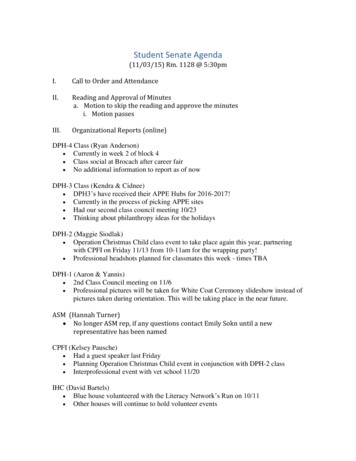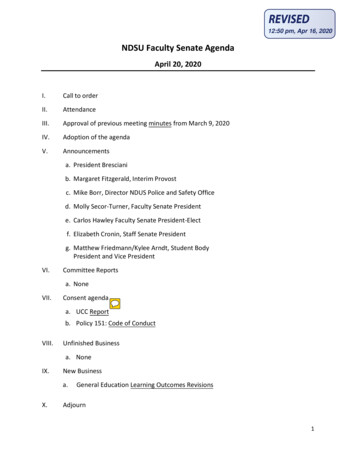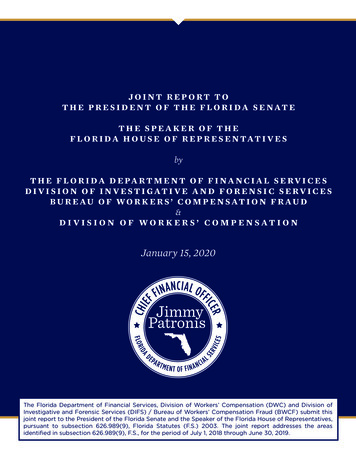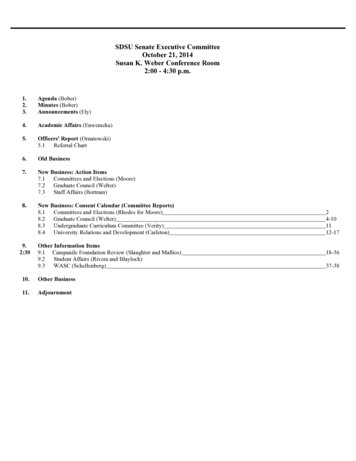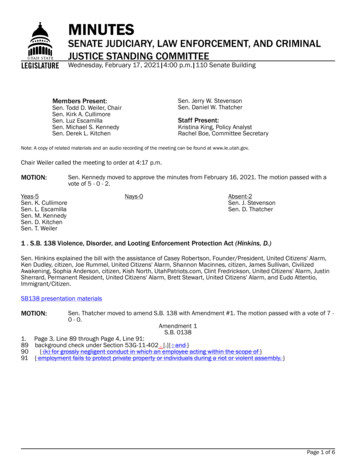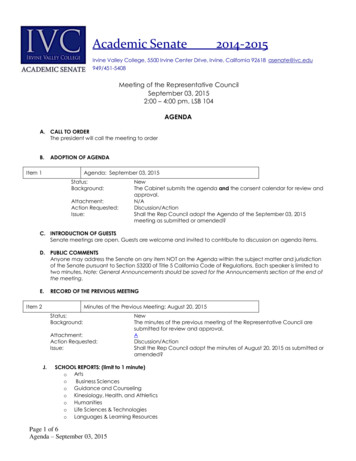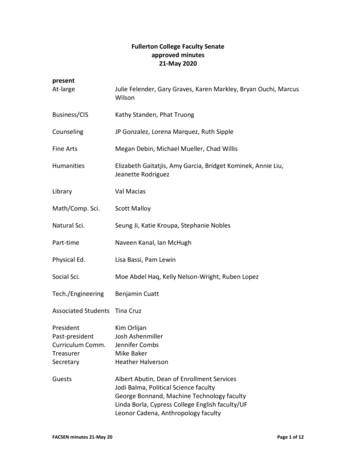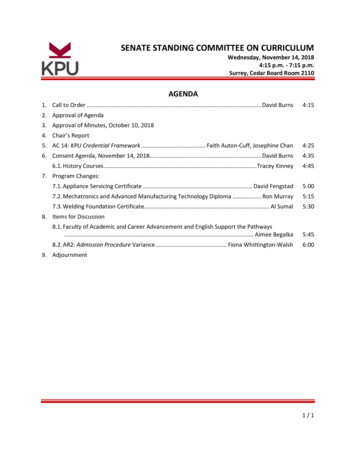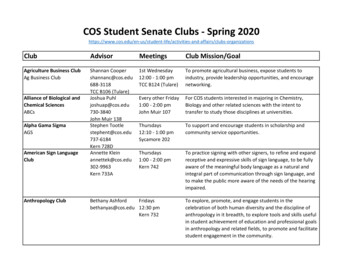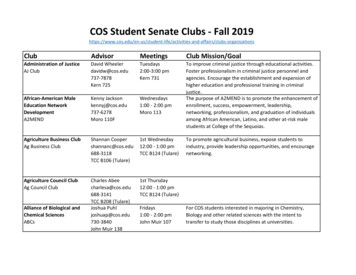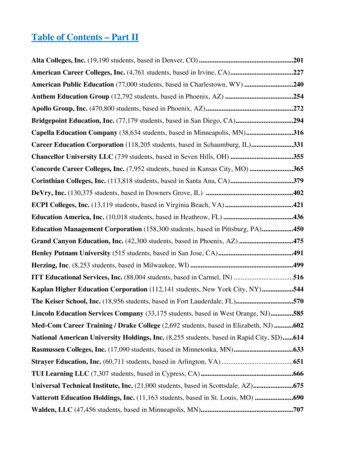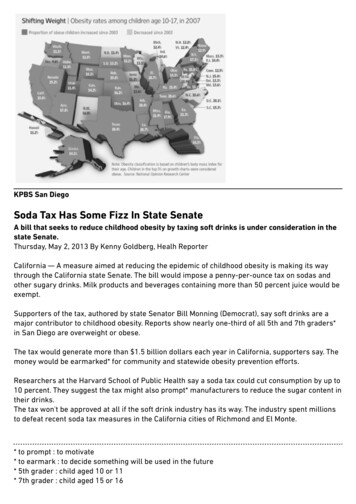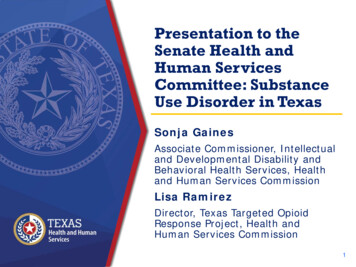
Transcription
Presentation to theSenate Health andHuman ServicesCommittee: SubstanceUse Disorder in TexasSonja GainesAssociate Commissioner, Intellectualand Developmental Disability andBehavioral Health Services, Healthand Human Services CommissionLisa RamirezDirector, Texas Targeted OpioidResponse Project, Health andHuman Services Commission1
Presentation Outline Substance Use Disorder (SUD)Overview Maternal Mortality andNeonatal Abstinence Syndrome Texas Targeted OpioidResponse Grant2
Substance Use Disorder:Statewide CoordinationStatewide Behavior Health StrategicPlan and Coordinating Council 23 CoordinatingCouncil Agencieswork together toaddress behavioralhealth issues inTexas, includingsubstance usedisorder CoordinatingCouncil agenciescoordinate around29 SUD programs3
Substance Use Disorder:Statewide CoordinationTotal SUD Funding for CoordinatingCouncil AgenciesFunding TypeFY 2018FY 2019General Revenue 228,302,008 233,048,425General Revenue- Dedicated-- 312,993,652 312,993,652InteragencyContract 1,136,447 1,136,387Other 3,967,275 18,632 546,399,382 547,197,096Federal FundsTOTAL4
Substance Use Disorder:Points of Entry into SystemOutreach, Screening, Assessment andReferral (OSAR) Site 14 OSAR programs arelocated at Local MentalHealth / BehavioralHealth Authorities(LMHAs/LBHAs) At least one OSAR islocated in each of the11 Health and HumanService Regions OSARS may be the firstpoint of contact forthose seekingsubstance use disordertreatment services Approximately 30,000people served annuallyby OSARs Approximately 7 million in annualfunding5
Substance Use Disorder:Points of Entry into SystemVisit: www.MentalHealthTX.org The SubstanceAbuse and MentalHealth ServicesAdministration(SAMHSA)behavioral healthtreatment servicelocator is an onlinesource ofinformation forpersons seekingsubstance usedisorder and/ormental healthtreatment facilities.6
Substance Use Disorder: HHSCNon-Medicaid Indigent Care ProgramsService ArrayProgramPrevention Youth Prevention EducationPrevention Resource CentersCommunity Coalition PartnershipsIntervention Outreach, Screening, Assessment and ReferralPregnant and Postpartum InterventionParenting Awareness and Drug Risk EducationRural Border InitiativeHIV OutreachHIV Early InterventionTreatment Adults: Detox, Residential, Outpatient, Specialized Women,Medication Assisted, Co-Occurring, HIV ResidentialYouth: Intensive Residential; Supportive Residential, OutpatientRecovery Recovery Support ServicesPeer Support and Peer Recovery ServicesInitiatives Neonatal Abstinence SyndromeStrategic Prevention Framework for Prescription DrugsTexas Targeted Opioid ResponseFirst Responders – Comprehensive Addiction Recovery ActStatewide Youth Treatment ImplementationH.B. 13 Community Mental Health Grant ProgramS.B.292 Mental Health Grant Program for Justice-InvolvedIndividuals7
Substance Use Disorder:FundingNon-Medicaid Indigent Care*ServiceTreatmentFY 2018 Total Funding 108 millionIntervention 22 millionPrevention 47 millionTOTAL 177 millionFunding breakout: Federal: 76 percent; State: 24 percent*Includes state, substance abuse prevention and treatment and mental health blockgrants8
Substance Use Disorder:Treatment Services for Adults Approximately 35,000 individuals served annually Approximately 48 million in annual fundingAdult OutpatientIntensive ResidentialSupportiveResidential9
Substance Use Disorder: Eligibilityfor Adult Treatment ServicesEligible Populations Adults who meet the Diagnostic and Statistical Manual of MentalDisorders criteria for a substance use disorder Adults who meet financial criteria of below 200 percent federalpoverty levelRecommended Levels of Care Basedon Individual Assessments Detoxification: Under the care of medical personnel, individualsdetermined to be physically dependent on alcohol or othersubstances will be monitored to safely withdraw from thosesubstances. These individuals are referred to on-going treatment. Residential: Individuals enrolled are determined to require aresidential setting to facilitate recovery from impact of substanceson their lives. Services are provided 24 hours per day, 7 days perweek by a multidisciplinary team. Outpatient: Individuals who enroll in these services do not requirea structured environment to achieve recovery and meet theirtreatment goals. Medication Assisted Treatment (MAT): Individuals receivetreatment to alleviate the adverse physiological effects ofwithdrawal from the use of opiates to meet the individualized needsof the client.10
Substance Use Disorder:Treatment Services for Youth Approximately 4,500 individuals served annually Approximately 18 million in annual fundingYouth OutpatientIntensive ResidentialSupportiveResidential11
Substance Use Disorder: Eligibilityfor Youth Treatment ServicesEligible Populations Youth who meet the Diagnostic and Statistical Manual of MentalDisorders criteria for a substance use disorder Youth who meet financial criteria of below 200 percent federalpoverty levelRecommended Levels of Care Basedon Individual Assessments Residential: Adolescents 13 to 17 years of age enrolled aredetermined to require a residential setting to facilitate recoveryfrom impact of substances on their lives. Services are provided 24hours per day, 7 days per week by a multidisciplinary team. Young adults age 18 to 21 may be admitted to the serviceswhen the screening process indicates the individual's needs,experiences, and behavior are similar to those of adolescentclients.Outpatient: Individuals who enroll in these services do not requirea structured environment to achieve recovery and meet theirtreatment goals.12
Substance Use Disorder:Medicaid BenefitMedicaid SUD benefits are available in managed careand fee-for-service. In fiscal year 2015, treatmentcosts totaled 9.7 million. Benefits include: AssessmentDetoxification (ambulatory and residential)Residential treatmentOutpatient treatment (individual and group counseling)MATScreening, Brief Intervention, and Referral to TreatmentPer the Evaluation of Medicaid Spending and Outcomes forSubstance Use Disorder Treatment report HHSC publishedin November 2017, in fiscal year 2015: 5,967 unique individuals received the Medicaid SUDbenefitThe average cost per treated client with SUD was 12,003.90 while the average cost per un-treated clientwith SUD was 13,075.5613
Substance Use Disorder:Medicaid 1115 Waiver Of the initial 1115 Waiver projects, 56 included substance useservices such as:Integrated physical and behavioral health treatmentIncreased access to substance use treatmentImproved interventions to justice-involved individuals who also needsubstance use servicesCoordinated care among health systems These 1115 Waiver projects collectively received more than 432 million in the first 6 years of the Delivery System ReformIncentive Payment (DSRIP) program. In December 2017, the Centers for Medicare and MedicaidServices (CMS) approved a five-year extension of the 1115waiver through September 30, 2022. CMS approved four additional years for the DSRIP program.HHSC must submit a DSRIP Transition Plan to CMS by October1, 2019. This plan will include Texas’ milestones to assuresustainability of delivery system reform efforts when DSRIPfunding ends. For example, a milestone could relate to contractual targets forMedicaid managed care organizations in 2020 - 2021 for shifting tovalue-based care, or to other pay-for-quality efforts in Medicaidmanaged care.14
Substance Use Disorder:Related LegislationH.B. 13, 85R (2017)S.B. 292, 85R (2017)State Fiscal Year 2018: 10 millionState Fiscal Year 2019: 20 millionState Fiscal Year 2018: 12.5 millionState Fiscal Year 2019: 25 million Continuity of care between inpatient andoutpatient services Outpatient Competency Restoration Transportation services Continuation of a mental health jaildiversion program Outpatient SUD services for adolescents Assertive Community Treatment Outpatient mental health and SUDservices for veterans Forensic Assertive Community Treatment Building community collaboratives Intensive mental health services andSUD treatment not readily available inthe county Partnerships with Federally QualifiedHealth Clinics to provide integratedhealthcare Local community hospital, crisis, respite,or residential beds15
Texas Neonatal Abstinence Syndrome (NAS) etedOutreachandEngagementStudy16
Texas Neonatal Abstinence Syndrome Trends1350NAS 01517
Neonatal Abstinence Syndrome:County share of Texas MedicaidNewborns with NAS, is12%13%9%7%6%Nueces5%4%5%7%5%*Of the total NAS designated births in Texas18
Neonatal Abstinence Syndrome:Texas Medicaid NICU DataDataPoints20112012201320142015Total Lengthof Stay(LOS)18,01720,98921,31719,12220,549Average LOS26.727.226.722.120.5Total Cost inMillions 27.3 27.7 29.2 28.1 28.7 40,586 35,998 36,642 32,589 28,710 44.3 45.4 43.2 48.1 56.7AverageCostAll MedicalCare forFirst Year ofLife inMillions19
Maternal Mortality: MaternalOpioid Morbidity Study (MOMS)MOMS emerging themes: Losing the babyNeed for supportExposure to traumaMental health symptoms20
Maternal Mortality: Statistics21
Texas Targeted Opioid ResponseGrant - 27 imaryPrevention22
Substance Use Disorder:Opioid Treatment Services Approximately 2,700 individuals served annually Approximately 9 million in annual fundingOpioid Treatment Services23
Opioid Epidemic: Overdose TrendsDeaths per 100,000 Population5Opioid-Related Overdose Death Rates: 1999-2015TexasUnited States54433221101999019992003200720112015Natural and Semi-Synthetic Opioids2003Heroin200720112015Synthetic Opioids24
Texas TargetedOpioid Response: PreventionProjects: Distributing federalguidelines and relatedmaterials to allprescribers in Texas Developing marketingcampaign to increaseTexas PrescriptionMonitoring Drug Programregistration andutilization Supporting safeprescription VeterinariansSubstanceAbusePreventionProviders Enforcement Expanding universalprevention programming25
Texas TargetedOpioid Response: TrainingProjects: “Opioid 101” Opioid MisusePrevention Summit ComprehensiveOverdose Prevention MAT Advocacy Suicide & OverdosePreventionPartners:MAT ProvidersSubstanceAbusePreventionProvides riansPublic orcementOxford HousesCriminalJusticeRecoveryCoaches26
Texas Targeted Opioid Response:Intervention and TreatmentProjects:Partners: OSAR expansion Mobile Crisis OutreachTeams responding toopioid-related crisisevents Expanding MAT Expanding Office-BasedOpioid TreatmentPublicHealthMATProvidersLMHA/LBHA Adding treatment forcomorbid conditionssuch as hepatitis C27
Texas TargetedOpioid Response: RecoveryProjects: Hiring additionalRecovery Coaches Expanding sober living Expanding peerre-entry program Adding supportedemployment programsto partner with dicalService28
Texas Targeted OpioidResponse: Living Downstream Many individuals with benefits notidentified and treated prior to povertyand uninsured status High need, but flat or limited fundingfor indigent services Texas population is growing Large geographic areas withoutproviders Cost driver for medical and mentalhealth system29
Texas Targeted Opioid Response:Evidence-Based PracticesImplications The level of care and “post-treatment”supports an individuals needs is notalways available or close to home. Most individuals experiencing OpioidUse Disorder are not obtainingmedication assisted treatment. The availability of supportive housing,supportive employment, and peerservices is limited.30
Texas Targeted OpioidResponse: Reversing the Trend Identify and ensure appropriate access forthe insured Fuller treatment/support array includingpeer engagement Decreased indigent demand Better geographic coverage Allows smaller purchases of substance usedisorder treatment for the indigent More access to appropriate levels of carein local areas Promotes engagement and positiveoutcomes: closer to supports, homes, andjobs Decreases costs overall31
Texas Targeted Opioid Response:Barriers and RecommendationsBarriersRecommendations1. Consistency in SUD-related policy and guidelines across statesystems2. Lack of geographic access tothe full SUD service array2. Address gaps by providing SUDtreatment as appropriate3. Lack of engagement andretention of patients withSUD3. Improve linkage from healthsystems to recovery supportservices4. Lack of screening andappropriate referrals totreatment in healthcaresystems4. Increase training andimplementation of ScreeningBrief Intervention and Referralto Treatment (SBIRT) includingavailable resources32
APPENDIX33
Texas Targeted Opioid Response:Contracts Summary by Region - 500,000 1,000,000 1,500,000 2,000,000 2,500,000 3,000,000 3,500,000Region 1, LubbockRegion 2, AbileneRegion 3, DallasRegion 4, TylerRegion 5, BeaumontRegion 6, HoustonRegion 7, AustinRegion 8, San AntonioRegion 9, MidlandRegion 10, El PasoRegion 11, Corpus ChristiStatewidePreventionIntervention, Treatment & Recovery34
Mar 22, 2018 · For example, a milestone could relate to contractual targets for Medicaid managed care organizations in 2020 - 2021 for shifting to . Expanding sober living Expanding peer re-entry program Adding supported employment programs to partner with MAT providers Partners: 28 Criminal Justice. MAT Providers. LMHA/ LBHA.
